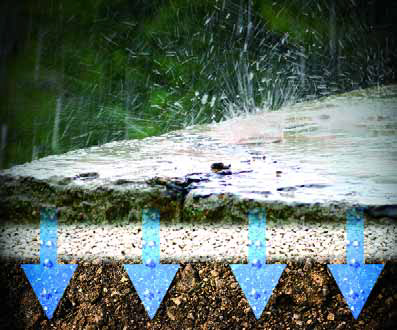I’ve taken up a fair amount of my column space in WaterShapes with discussions of the wise use of water, and for good reason: What could be more important to watershapers than knowing how to make the best possible use of the material that defines our profession? And what could be better than the fact that it’s possible to approach the subject in positive ways that bode well for the future? The common thread in all of this coverage – whether it’s about conservation, constructed wetlands or rainwater harvesting – is that, ultimately, our aim must be to
It seems like ages ago, those glowing days when a spa – whether separate from or connected somehow to a swimming pool – stood on the absolute cutting edge of residential watershaping. These days, by contrast, systems designed to deliver hot water and hydrotherapy to our clients have become so familiar that they’re almost taken for granted. From what I’ve heard, it’s almost reached the point where discussions leading up to some of the best custom projects are treating spas as
If you’re like most people, you probably don’t give much thought to where the water we drink originates. Our supplies of this precious commodity are so reliable, ample and safe that we mostly just go to the tap and use what we need. I was once that carefree, but no more. As I see it, ignorant bliss is actually inexcusable these days, not only because each of us needs a ready supply of potable water to survive and maintain the quality of our lives, but also because
Concrete is an utterly amazing material, but it’s so widely used – so pervasive in our world – that it’s easy for the average person to take it for granted and barely give it a second thought. As watershapers, of course, we don’t have the luxury of underestimating concrete: With the sole exception of water, it’s far and away the most essential of all the materials we use across a huge range of applications. We simply could not do what we do without it. But how often do we deploy concrete in purely aesthetic ways? Some of us use artificial rock or specialized decking treatments, but isn’t it mostly true that we build our structures from concrete and then systematically cover it up with plaster, stone, tile or some other surfacing material? It didn’t take long for me to start
With watershapes, sometimes the most straightforward forms work out best. That was definitely the case with this project, a swimming pool I designed and built for a beach club near my home in Guanacaste, Costa Rica. The club is part of an overall resort property known as Reserva Conchal, an utterly spectacular spread covering 2,500 acres on scenic Playa Conchal on our country’s north Pacific coast. I first became involved with the resort’s owners about ten years ago, when they were completing their first phase and I helped them solve some problems with a pool that had been built by another firm. Since then, as the owners’ master plan has gradually unfolded, I’ve worked with them on a number of pools in various spots around the huge property, including watershapes for various condominiums and other facilities. My involvement with their newly constructed club has been, by far, the most
Everything about this project was classic and beautiful. For one thing, the home has the soft look of a French country chateau. For another, it’s located in Hancock Park, one of the oldest of Los Angeles’ upscale downtown neighborhoods. And when you add in the fact that it sits on a half-acre-plus lot on a quiet street, we had the pleasing sense that we’d landed on a refreshing oasis at the heart of a bustling metropolis. We also enjoyed the privilege of working here with Andres Cardenes, a wonderful architect who had collaborated with these clients on and off for several years. In their latest endeavor, he had come in to refurbish the home along historic and formal lines – something that often happens in this neighborhood, which boasts numerous restored and beautifully maintained homes across a range of architectural styles. Our firm, New Leaf Landscape of Agoura Hills, Calif., had worked with Cardenes on previous projects. When he called, he talked a bit about the situation and let us know that he thought we’d be a great fit because of the way we
There’s something truly wonderful about working on properties that are in one way or another historic: In a very real sense, they give you a rare opportunity to participate in the past while at the same time you are conceiving and forming a place for the future. This project is a case in point: My endeavors here gave me the chance to beautify a truly splendid 1905 private home in southern Wisconsin and complement its amazing Palladian/Greek Revival-style bone structure with a contemporary composition in rock, plant material and water. The owner, who has a passion for architecture and historic preservation, had already completed a total restoration of the buildings. The grounds, however, still left much to be desired. The property manager had worked with me on a previous project, and he suggested that I should be brought in to revitalize the space – the centerpiece of which would turn out to be
For more than 10 years now, outdoor rooms have been growing steadily in both popularity and complexity. That’s great, because it enables designers – architects, landscape architects, landscape designers and pool builders alike – to bring interiors outside and provide living spaces where activities previously associated strictly with indoor spaces can move comfortably into the great outdoors. It’s a fantastic way to expand living areas and create useful spaces while also adding entirely new types of experiences to the lives of homeowners. Among this trend’s many implications is that it has challenged landscape lighting designers to think in all-new ways about how we light exterior spaces. For starters, we need to be aware that most homeowners will enjoy these spaces exclusively after dark – and also be conscious of the fact that these environments require much more complicated lighting schemes than classic suburban patios ever did. The differences are so profound that I believe lighting designers need to talk to clients in new ways that
Not long ago, I did a pair of columns on healing gardens and their benefits. If you’ll recall, I preached the importance of persuading hospitals in particular to include these spaces in their overall site plans as a means of providing garden environments for patients, patients’ families and hospital staff: These spaces reduce stress, help patients heal more quickly and give everyone who visits them a soothing sense of tranquility. I’ve attempted to the greatest extent possible to practice what I preached, and through the years I’ve installed numerous health-specific gardens at local assisted-living centers, Alzheimer’s care facilities and even at a center for emotionally-challenged children. But truth be told, I haven’t met with much success with our local hospitals, despite the fact that healing gardens have caught on with countless such facilities coast to coast. I don’t know quite why this is, but we






















